高一英语必修四Unit4_Language_points
- 格式:ppt
- 大小:999.00 KB
- 文档页数:53
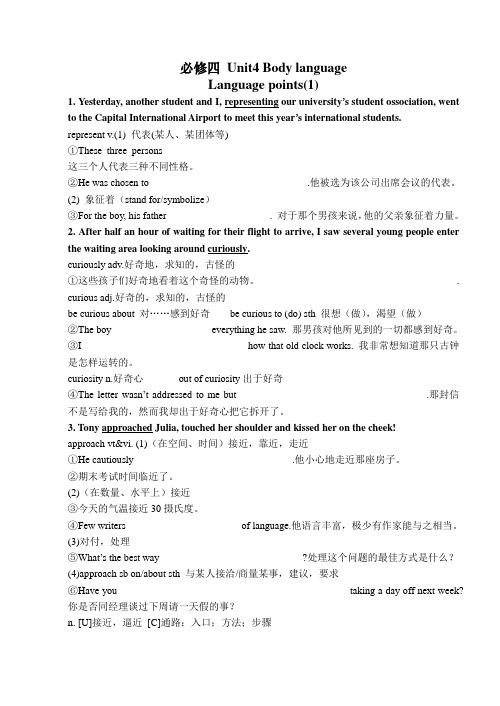
必修四Unit4 Body languageLanguage points(1)1. Yesterday, another student and I, representing our university’s student ossociation, went to the Capital International Airport to meet this year’s international students.represent v.(1) 代表(某人、某团体等)①These three persons __________________________________________________________这三个人代表三种不同性格。
②He was chosen to _______________________________.他被选为该公司出席会议的代表。
(2) 象征着(stand for/symbolize)③For the boy, his father ____________________. 对于那个男孩来说,他的父亲象征着力量。
2. After half an hour of waiting for their flight to arrive, I saw several young people enter the waiting area looking around curiously.curiously adv.好奇地,求知的,古怪的①这些孩子们好奇地看着这个奇怪的动物。
________________________________________. curious adj.好奇的,求知的,古怪的be curious about 对……感到好奇be curious to (do) sth 很想(做),渴望(做)②The boy ___________________ everything he saw. 那男孩对他所见到的一切都感到好奇。
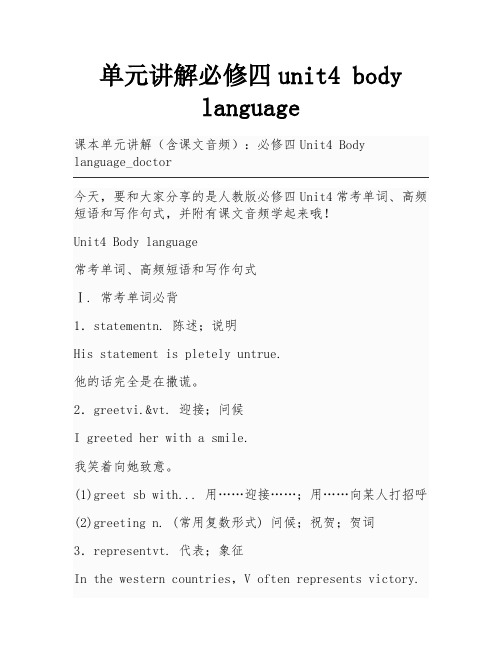
单元讲解必修四unit4 bodylanguage课本单元讲解(含课文音频):必修四Unit4 Body language_doctor今天,要和大家分享的是人教版必修四Unit4常考单词、高频短语和写作句式,并附有课文音频学起来哦!Unit4 Body language常考单词、高频短语和写作句式Ⅰ. 常考单词必背1.statementn. 陈述;说明His statement is pletely untrue.他的话完全是在撒谎。
2.greetvi.&vt. 迎接;问候I greeted her with a smile.我笑着向她致意。
(1)greet sb with... 用……迎接……;用……向某人打招呼(2)greeting n. (常用复数形式) 问候;祝贺;贺词3.representvt. 代表;象征In the western countries,V often represents victory.在西方国家,V常象征着胜利。
He represented himself as a doctor.他自称是一个医生。
[快速闪记](1)represent sth to sb 向某人说明某事,向某人传达某事represent...as... 把……描绘成……represent oneself as/to be... 自称是……(2)representative n. 代表4.curiousadj. 好奇的The children were curious to know what was happening over there.孩子们很想知道那边发生了什么事。
[快速闪记](1)be curious about 对(某事物)感到好奇be curious to do... 很想做某事;渴望做某事(2)curiously adv. 好奇地5.approachvt..&vi.接近;靠近;走近 n. 接近;方法;途径As summer approached,the weather became hotter and hotter.随着夏天的临近,天气越来越热。
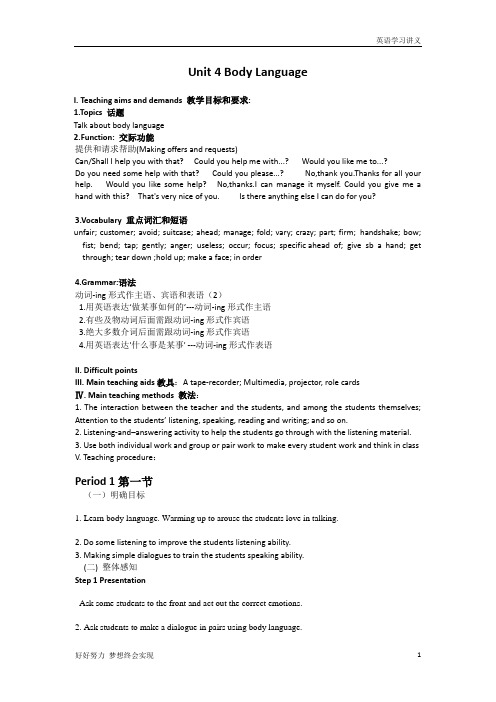
Unit 4 Body LanguageI. Teaching aims and demands 教学目标和要求:1.Topics 话题Talk about body language2.Function: 交际功能提供和请求帮助(Making offers and requests)Can/Shall I help you with that? Could you help me with...? Would you like me to...?Do you need some help with that? Could you please...? No,thank you.Thanks for all your help. Would you like some help? No,thanks.I can manage it myself. Could you give me a hand with this? That's very nice of you. Is there anything else I can do for you?3.Vocabulary 重点词汇和短语unfair; customer; avoid; suitcase; ahead; manage; fold; vary; crazy; part; firm; handshake; bow; fist; bend; tap; gently; anger; useless; occur; focus; specific ahead of; give sb a hand; get through; tear down ;hold up; make a face; in order4.Grammar:语法动词-ing形式作主语、宾语和表语(2)1.用英语表达‘做某事如何的’---动词-ing形式作主语2.有些及物动词后面需跟动词-ing形式作宾语3.绝大多数介词后面需跟动词-ing形式作宾语4.用英语表达'什么事是某事' ---动词-ing形式作表语II. Difficult pointsIII. Main teaching aids教具:A tape-recorder; Multimedia, projector, role cardsⅣ. Main teaching methods 教法:1. The interaction between the teacher and the students, and among the students themselves; Attention to the students’ listening, speaking, reading and writing; and so on.2. Listening-and–answering activity to help the students go through with the listening material.3. Use both individual work and group or pair work to make every student work and think in class V. Teaching procedure:Period 1第一节(一)明确目标1. Learn body language. Warming up to arouse the students love in talking.2. Do some listening to improve the students listening ability.3. Making simple dialogues to train the students speaking ability.(二) 整体感知Step 1 PresentationAsk some students to the front and act out the correct emotions.2. Ask students to make a dialogue in pairs using body language.(三)教学过程Step 2 Warming upGo through warming up and make sure the students understand it and can match each picture with the correct emotion and the correct sentence.Answers (From left to right):1 Picture 1: Confused I don't know what to do.2: Angry I can't believe she said that! That is so unfair!3: Sad I've lost my wallet!4: Happy I got an A in my exam!5: Tired It's been a long day. I can't keep my eyes open.2 Various answers are possible but explanations for choices should refer to details in the pictures.3 Various answers are possible.Step 3 Listening comprehensionNow let s have some listening training.LISTENING TEXT:Part 1Which of the following is a form of communication?A Speaking to someone.B Standing in a comer at a party with your arms crossed.C Avoiding eye contact with the salesman when you are buying something.D All of the above.Speaking, or using language to communicate, is probably the best known form of communication. However, the body language used in answer B and the lack of eye.contact in answer C can say as much or more as speech.Let's take a closer look at answer B. You are at a party and see your friend Tom standing alone in a comer with his arms crossed. When you ask him if he is enjoying the party, he says, "Yes, I'm having a great time." Do you believe him? Probably not, because his body language is telling you that he doesn't like being there. If someone asks you later whether you think Tom liked the party, you might say "He said he enjoyed it, but it didn't look like it."Now let's look at C. Imagine that you are a salesman at a store. You always greet your customers with a smile and then talk for a while. But what if one of your customers avoids making eye contact with you? Do you still speak to her? Probably not. By not looking at you, she has told you that she doesn't want to talk to you.Part 2Body language can help you decide whether a person is telling the truth or not. If a person covers his or her mouth with his or her hand, or if he or she puts his / her finger over his / her mouth, he or she may be lying. If the person you are talking to touches his or her ears or neck, this is also a sign that he or she may not be telling you the truth. How can you tell if the person you are talking to is interested in what you are saying? Watching his or her body language will give you a goodidea. Someone who is interested will lean forward in their seat and will look at you when you are speaking. They may also nod their head to show that they are listening and agree with what you are saying.1 Answers to Part 1 : ID 2B 3AAnswers to Part 2: IB 2B2 Answers will vary but here are a few appropriate ways to communicate each feeling using body language.Enjoying sthsmiling, opening eyes wide, rocking one's head from side to sideLiking someonesmiling, hugging oneself, leaning one's head to one side, lowering with one's eyes, leaning forward or closerInterested in sthstaring a lot, putting a hand 10 your chin as in thought, leaning forward, opening eyes wide, shaping your mouth with a big 0, responding with the same expressions as the person who you're listening toDisagreementlooking away, putting one's head down into one's arms, talking to oneself, whistling, frowning, folding one's armsNot enjoying sthyawning, sighing, complaining, frowning, looking awayIn a hurrysighing, biting down with one's teeth, not standing still, tapping one's toes on the floor, looking toward the doorNot interestedsame as not enjoyingWanting to talk to othersraising one's hand to be called on, trying to speak up, waving one's arms over one's head to }&et attention, jumping up and down, shaping one's mouth in a big 0Step 4 Speaking practiceSituation 1: An old man is carrying a very heavy suitcase.Asking for help(0 = Old man; P = Paul)0: Excuse me, young man. Could you give me a hand with this, please? It's very heavy.P: Oh, of course, I'd be happy to. There we go.0: Thank you.P: You're welcome.0: Oh my, this is heavy. Excuse me, sir, could you help me with this bag?P: Certainly. Where should I put it?0: Thank you. Just put it over there, please.P: There you are.0: Thank you, that's very nice of you.P: Dh, not at all.Offering helpP: That bag looks very heavy. Do you need some help with that?0: Oh, thank you. Could you please put it over there? P: No problem. There you are. Is there anything else I can do for you?0: No, thank you. Thanks for all your help.P: Woultl you like some help?0: Oh, yes, please. This bag is simply too heavy for me. Could you give me a hand with it?P: Sure. My, this bag is heavy! Ah, there we go. Where shall I put it'?0: Over there, please. Thank you so much!P: You're welcome.Situation.2:..Someone is late for a flight and wants to go ahead of the queue.(J = Jim; A = Passenger A; B = Passenger B)J: Excuse me, but I'm late for my flight. Could I please go ahead of you?A: Why sure. My flight doesn't leave for another hour. Are these bags yours? Shall I help you with that?J: No, thanks. I can manage it myself. (To the passenger standing at the check-in counter.) Hi. May I cutin front of you? I don't want to miss my plane.B: Go right ahead. I'm still looking for my ticket. Do you need some help with that bag?J: Yes. Could you please help me put it up here? Thank you.B: You're welcome.J: Oh no! I'm late for my flight.A: Excuse me, but did you say that you were late? Would you like to-go ahead of me? My flight doesn't leave for another hour.J: Thank you, that's very nice of you! Could you helpme with this bag, please?A: Sure. There you are. Would you like me to bring it up to the counter?J: Oh, no, thank you. I can manage it myself now.Situation 3: An old and sick person is on a crowded bus and wants to sit down.(0 = Old person; P = Passenger)0: Oh my, this bus is crowded. Excuse me, could you please help me with this bag?P: Certainly. There you are. Here, please take my seat, you look a bit tired.0: Thank you. Yes, I'm not feeling well today. I think I have a bit of a cold. Could you please tell me when we reach Long Street? I'm afraid I can't see where we are when the bus is this crowded.P: Sure. I'll let you know when we get there.P: Shall I help you with that?0: No thanks. I can manage it myself. But could you please let me sit down for a while? I'm not feeling well.P: Oh, of course. Please take my seat.0: Thank you. That's very nice of you.P: Not at all.(四)总结扩展Step 5 Necessary language pointsToday we ve done some listening and speaking, and learn how to give advice and some everyday English used between doctors and patients.Listening and speaking听说要点1>What if a customer avoids making eye contact with you?What if ...? [用法]假使...呢?;若是...又怎么样?[举例]What if he doesn't come (What shall we do if he doesn't com)? 如果他不来,我们怎么办呢?What if it's true (Even if it's true, does it mattere)? 即使这是真的,又有什么关系吗? avoid [用法]vt. 避免[举例]They all avoided mentioning that name. 他们都避免提及那名字。

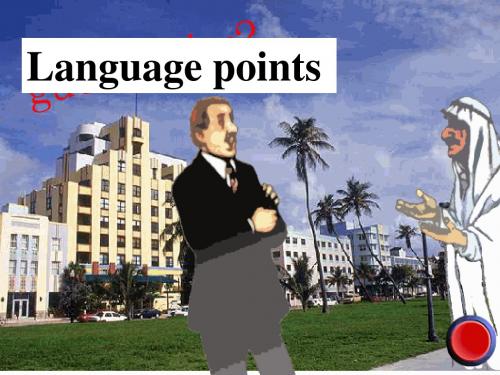
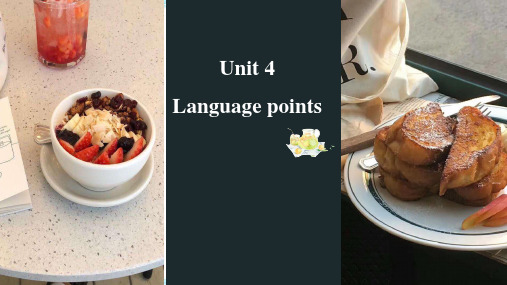
Lesson plan for Great ScientistsTeachi ng Procedurese.The new hybrid rice has been developed by the Yuan Longping High-tech Agriculture Company of China.T:Now answer the following questions.1 .Which sentence is in the present simple(passive voice)?2 .Which sentences are in the past simple(passive voice)?3 .Which sentence refers to the future?4 .Which sentence is in the present perfect?3. Present the passive voice with four tenses on PPT the present simple, the past simple, the futuresimple, and the present perfect; then explain the usage of the sentences from the PPT one by one.4. Conclude the forms of the passive voice and show it on PPT. Let Ss learn to observe the sentences structures and distinguish the different tenses.The teacher guides the students to make a simple summary of the voice they have learned and form a clear concept of it.Stage 3 Practice (10mins)1. Ask Ss to do the exercise 1 and exercise 2 of different tenses about the passive voice. 厂 一Exercise 1 J 1.1 vxltfl monry ______ . Ihe lliedltv illA. was fnundB. find 吊 1 round Ik fonrid«rv cnnriiJ<nt ihiHenvironment _______ hy our furthervl'Jbrh tu induct pullulion.A. had been improved ' hr iniproi «dC?. k impiwcd 1). WHS improvrdXU nalliing _______ , Uiv(K?c3ns «111 turn inlo I LS J I deserts,A. doe\ B* h 刘d been done will 号 JuneExercise 2Fill in the blanks.Part oneLihui: Let's learn other scientists.Lihua: Cailun is a great inventor I'd like to talk.Lihui: Great,we all know that Papermaking _____________________ (invent) by him.Lihua:Yes,with the development of society, different types of paper _____________________ (develope) sofar.Lihui:Maybe in the future, new paper ________________ (create) and ________ (use) in other area.Part 2Tom:Do you know some famous scientists?Tina:Yes,Stephen Hawking,he _________________ (know) at home and abroad widely.Tom:for example?Tina:He ___________ (graduate) from Oxford University.In the 1960s,He (diagnose)with motor neurone disease.but he never gave up, his book A Briefbe +doneDesigning purposeHistory of Time(publish)in 1988.He is so outstanding and we(influence) by him.Tom:Right.we all believe his work(use) in other new field that(explore) by others scientists recently.Stage4 Production Discussion and making sentences in groups.(11 mins ) 1.Teacher show some pictures in the PPT, then ask Ss to discuss and describe the picture byusing the correct form of passive voice in groups. And some prompts are given besides the picture.T: I think you have learned passive voice by hearts. Now, we will make some sentences in passive voice inpassive voice.You know,we should learn not only their forms but also how to use them correctly. Ask Ss todiscuss the exercise in groups and finish it.Practice 1: Make sentences according to the pictures and given words.2.Write a short dialogue within sive sentences to describe the scientists with the right types of PV.Scientists are as follows:MadameCurie,Edison ect.3.Give some comments on the Ss' performance and then give a brief conclusion.Blackboard/PPT Design(板书 /媒体设计)Module 4 The Passive VoiceBe+done1.the present simple: am/is/are+done2.the past simple: was/were+done3.the future simple: will be+done4.the present perfect: have/has+been+done。
Unit 4 Body LanguagePart One: Teaching DesignTeaching goals1. Target Languagea. 重点词汇和短语重点词汇和短语misunderstand, similar, facial, expression, agreement, yawn, chest, gesture, adult, punishb. 重点句型或交际用语重点句型或交际用语Act out the following meanings, please.Please guess what I mean.Please show the actions, using body language.Now it is your turn to show the action / gesture.Please use either spoken words or body language to express your ideas.Please use both spoken words and body language to express your ideas.2. Ability goalsa. Enable the students to understand what a certain gesture of the body language means in a given situation.b. Enable the students to act out some meanings, requirements, requests or situations given in the target language.c. Enable the students to express with the target language the meanings given in body language.3. Learning ability goalsa. Help the students learn how to express themselves in body language when needed.b. Help the students understand others when body language is being used.Teaching important pointsa. Teach the students how to understand body language used in different countries or cultures as well as in different occasions.b. Teach the students how to use body language in the most appropriate occasions. Teaching difficult pointsa. Enable the students to realize the importance of body language in communication so that little or no misunderstanding may occur.b. Let the students know that there is both positive body language and negative body language.Teaching methodsa. Individual work, pair work and group work.b. Acting out by imitation, mime or with gestures and body movement.Teaching aidsA computer, a projector and some pictures.Teaching procedures & waysThe first period reading(COMMUNICATION: NO PROBLEM?)AimsTo help students develop their reading ability.To help students learn about body language.ProceduresI. Warming upWarming up by actingLook at the list of interpretation on the right side of the chart. Perform the action or the nonverbal behaviour on the left side.Examples Of Body LanguageWarming up by defining—What is body language?II. Pre-reading1. Looking and sayingLook at the man in the picture below. What does he say to you by his body language?Basically, how the ...... do I know? Or, I don’t know nothin! The shoulders are hunched and the hands are open signifying a big question mark.2. Talking and sharingBody language is the quiet, secret and most powerful language of all!According to experts, our non-verbal language communicates about 50% of what we really mean (voice tonality contributes 38%) while words themselves contribute a mere 7%.Our bodies send out messages constantly and often we don't recognize that we're communicating a lot more than we realize.Our understanding and use of non-verbal cues in facial expression are familiar to us nearly from birthIII. Reading1. Reading aloud to the recordingNow please listen and read aloud to the recording of the text COMMUNICATION: NO PROBLEM?. Pay attention to the pronunciation of each word and the pauses within each sentence. I will play the tape twice and you shall read aloud twice, too.2. Reading and underliningNext you are to read and underline all the useful expressions or collocations in the passage. Copy them to your notebook after class as homework.3. Reading to identify the topic sentence of each paragraphNext you are to skim the text to identify the topic sentence of each paragraph.4. Reading and transferring informationRead the text again to complete the table. Where is he/ she from? What does he/ she do when he/ she meet someone at the airport for the first time?Name Country Action MeaningMr GarciaJulia SmithAhmed AzizMadame Coulon5. Reading and understanding difficult sentencesAs you have read the text times, you can surely tell which sentences are difficult to understand. Now put your questions concerning the difficult points to me the teacher.6. Reading and translatingNow it’s time to translate the text into Chinese, sentence by sentence. Who will be the first to d o it?IV. Closing downClosing down by doing exercisesTo end the lesson you are to do the comprehending exercises No. 1 and 2 on page 26 and 27.Closing down by checkingC heck some of the following basic non-verbal cues and you'll recognize that you already speak and translate much of the language.“I’m surprised!” I’m shocked!” “I’m sad!”The second period Learning about Language(The ~ing form as the Attribute & Adverbial)I. Warming upWarming up by discovering useful words and expressionsTurn to page 27 and do exercises No. 1, 2 ,3 and 4 first. Check your answers against your classmates’.II. Learning about grammar1. Reading and thinkingTurn to page 25 and read with me the text of COMMUNICATION: NO PROBLEM? As you read along, pay attention to the uses of The ~ing form as the Attribute & Adverbial. (They are visitors coming from several countries. 作定语;Four people enter looking around in a curious way. 作状语;作状语; This is an exciting experience for you. 作定语; You stand watching and listening. 作状语;……)2. Doing exercises No. 1 and 2 on page 29Turn to page 29. Do exercises No. 1 and 2。
Unit4 Language points 单元分析一、教材分析本单元的中心话题是“身势语(Body language)”,单元各项活动的设计都围绕这个话题进行。
身势语是非语言交际中非常重要的一个方面,它与有声的语言一样,也是文化的载体,在跨文化交际中起着举足轻重的作用。
教师在教授本单元时,要提醒学生注意自己和他人在日常交际中的体态、姿势、面部表情等,正确地理解和运用身势语,以达到良好的交际效果。
为了围绕中心话题开展听、说、读、写活动,本单元安排了八个部分:“热身(Warming Up)”“读前(Pre-reading)”“阅读(Reading)”“理解(Comprehending)”“语言学习(Learning about Language)”“语言运用(Using Language)”“小结(Summing Up)”“学习建议(Learning Tip)”。
“热身(Warming Up)”由两部分组成。
练习1是让学生看图讨论身势语在日常交际中的运用。
练习2要求学生用身势语表演、猜测一些日常交际用语,旨在激活学生思维,开启学生心智,激发学生探求新知的欲望。
“读前(Pre-reading)”部分由四个问题组成。
这些问题集中引导学生思考“语言的目的”“离开语言人们交流的途径”及“预测下面阅读课文的内容”等,这些问题对前一部分和下一步的阅读教学起了承上启下的作用。
“阅读(Reading)”部分以机场迎接新同学为场景,讲述了来自几个不同国家的学生由于文化背景的差异进而互相问候的方式也迥然不同,在初次见面时造成一些小误会。
这形象地表明了身势语(Body language)与文化背景的密切关系,以及身势语在人们日常交际中的重要作用。
“理解(Comprehending)”部分设计了三个由浅入深、层层递进的练习。
旨在引导学生通过理解不同国家、不同身份和不同性别的人在初次见面时相互问候的情景,特别是身势语的使用细节,思考课文主题所隐含的跨文化交际的问题,引发学生对身势语的文化差异,意义进行积极的、深入的思考,如身势语无优劣的观点,激发学生的想象力,进一步地去探讨身势语交际的话题。